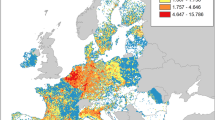Abstract
Invasive alien species have become one of the most serious environmental issues in the world. Data of taxon, origin, pathway, and environmental impacts of invasive alien microorganisms, invertebrates, amphibians and reptiles, fish, birds, mammals, herbs, trees, and, marine organisms in terrestrial, aquatic, and marine ecosystems of China were analyzed during 2001 and 2003, based on literature retrieval and field survey. There were 283 invasive alien species in China, and the number of species of invasive alien microorganisms, aquatic plants, terrestrial plants, aquatic invertebrates, terrestrial invertebrates, amphibians and reptiles, fish, and mammals were 19, 18, 170, 25, 33, 3, 10, and 5, respectively. The proportion of invasive alien species originated from America, Europe, Asia, Africa, and Oceania were 55.1, 21.7, 9.9, 8.1, and 0.6%, respectively. Methods for estimation of direct economic losses to agriculture, forestry, stockbreeding, fishery, road and water transportation, storage, water conservancy, environment and public facilities, and human health were established. Methods for estimation of indirect economic losses caused by invasive alien species to service functions of forest ecosystems, agricultural ecosystems, grassland ecosystems, and wetland ecosystems were also established. The total economic losses caused by invasive alien species to China were to the time of USD 14.45 billion, with direct and indirect economic losses accounting for 16.59% and 83.41% of total economic losses, respectively.
Similar content being viewed by others
References
LY Chen HG Xu (2001) ArticleTitleAustralian management strategy for invasive alien species and references available to China Biodiversity Science 9 IssueID4 466–471
W Fang (2000) Biological invasion and global change Jingyun Fang (Eds) Global Ecology Climatic Change and Ecological Response Higher Education Press Beijing
IUCN-The World Conservation Union (2000) IUCN Guidelines for the Prevention of Biodiversity Loss due to Biological Invasion (approved by the IUCN Council, February, 2000)
LR Jian MY Li (2004) ArticleTitleIndirect economic loss evaluation of biological invasion on crop-land ecosystem Journal of Jinling Institute of Technology 20 IssueID3 32–35
MY Li HG Xu (2004) ArticleTitleValuation of indirect economic loss of alien invasive species on wetland ecosystem Journal of Central South Forestry University 24 IssueID5 53–56
MY Li HG Xu (2005) ArticleTitleIndirect economic loss evaluation of effect of alien invasive species on forest ecological system Journal of Northwest Forestry University 20 IssueID2 156–159
ZY Li Y Xie (2002) Invasive Alien Species in China China Forestry Publishing House Beijing
YB Liang B Wang (2001) ArticleTitleAlien marine species and their impacts in China Biodiversity Science 9 IssueID4 458–465
GL Lovei (1997) ArticleTitleBiodiversity – Global change through invasion Nature 388 627–628 Occurrence Handle1:CAS:528:DyaK2sXlsV2ks7k%3D Occurrence Handle10.1038/41665
McNeely JA, Mooney HA, Neville LE, Schei P and Waage JK (2001) A global strategy on invasive alien species. IUCN Switzerland, Gland and Cambridge, UK, in collaboration with the Global Invasive Species Programme. X+50pp
SL Peng YC Xiang (1999) ArticleTitleThe invasion of exotic plants and effects of ecosystems Acta Ecologica Sinica 19 IssueID4 560–569
D Pimentel L Lach R Zuniga D Morrison (2000) ArticleTitleEnvironmental and economic costs of non-indigenous species in the United States Bioscience 50 53–65 Occurrence Handle10.1641/0006-3568(2000)050[0053:EAECON]2.3.CO;2
S Qiang XZ Cao (2001) ArticleTitleThe harmfulness of exotic weeds in China and for their management Biodiversity Science 9 IssueID2 188–195
Shine C, Williams N and Gundling L (2000) A guide to designing legal and institutional frameworks on alien invasive species. IUCN, Gland, Switzerland Cambridge and Bonn. xvi+138pp
FH Wan JY Guo DH Wang (2002) ArticleTitleAlien invasive species in China: their damages and management strategies Biodiversity Science 10 IssueID1 119–125
M Williamson (1996) Biological Invasions Chapman & Hall London
Y Xie ZY Li PG William D Li (2001) ArticleTitleInvasive species in China – an overview Biodiversity and Conservation 10 IssueID8 1317–1341 Occurrence Handle10.1023/A:1016695609745
HG Xu H Ding (2003) Countermeasures for the prevention of invasive alien species DH Wang C Fang (Eds) Conserving Biodiversity and Strengthening Nature Reserve Management China Environment Sciences Press Beijing 128–139
HG Xu S Qiang (2004) Inventory of Invasive Alien Species in China China Environmental Sciences Press Beijing
HG Xu JM Wang S Qiang CY Wang (2004) Study of Key Issues Under the Convention on Biological Diversity: Alien Species Invasion, Biosafety and Genetic Resources Science Press Beijing
LY Zhang WH Ye (2002) ArticleTitleCommunity invasibility and its influencing factors Acta Phytoecologica Sinica 26 IssueID1 109–114
Author information
Authors and Affiliations
Corresponding author
Rights and permissions
About this article
Cite this article
Xu, H., Ding, H., Li, M. et al. The distribution and economic losses of alien species invasion to China. Biol Invasions 8, 1495–1500 (2006). https://doi.org/10.1007/s10530-005-5841-2
Issue Date:
DOI: https://doi.org/10.1007/s10530-005-5841-2




